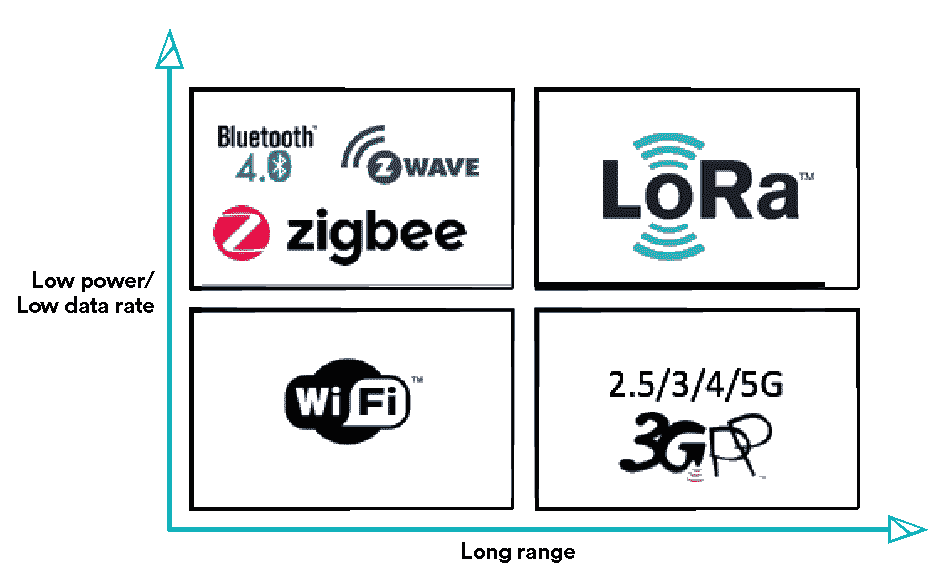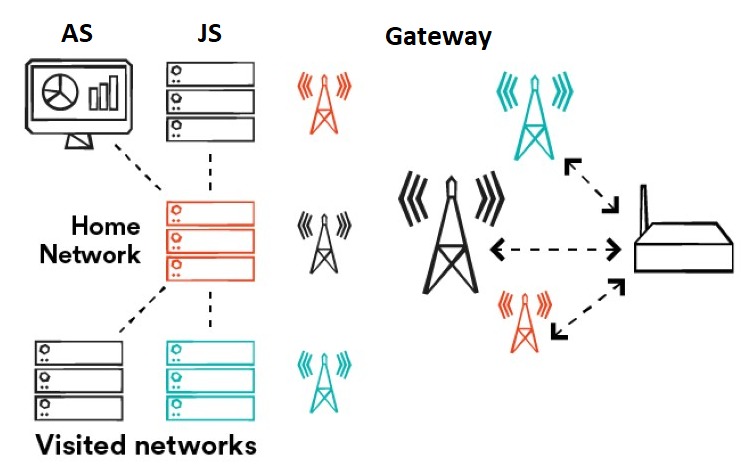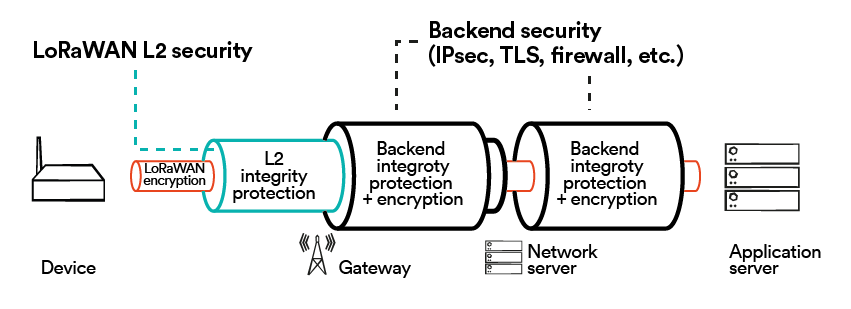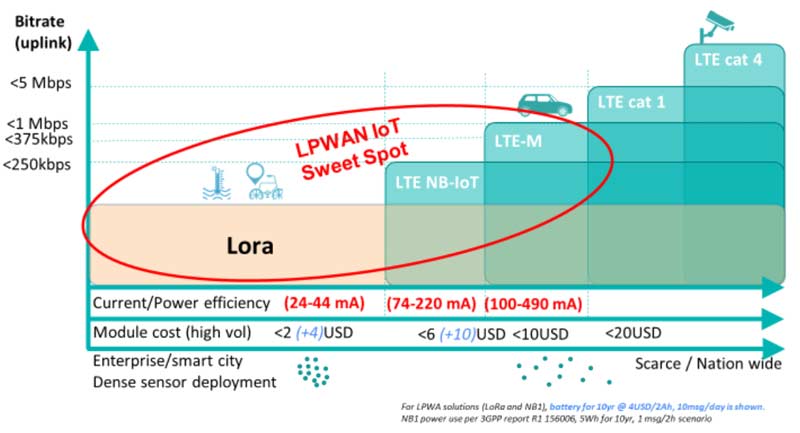LPWAN (Low-Power Area Network) is the new segment of wireless communications that specifically caters to IoT use cases that require battery-operated sensors and network coverage well-beyond 10s and 100s of meters. While technologies like Bluetooth LE, Zigbee, and Z-wave have provided a low-power but short-range solution, and long-range has been covered by 2.5/3/4G albeit in a power-hungry way, the sweet spot of long-range and low-power communications problem space has been looking for a standard technology with a strong ecosystem. This gap has been successfully filled by the LoRaWAN® technology.
Long-Range, Low-Power

Figure 1. Wireless communication technologies
Architecture
LoRaWAN® is the end-to-end wireless communication architecture that encompasses the LoRa® RF technology (the physical layer), the LoRaWAN® Link-layer that is used in between the end-device (the sensors/actuators) and the network, and the LoRaWAN® Backend interfaces used among the networks. A more comprehensive description is illustrated in Figure 2.

Figure 2. End-to-end LoRaWAN® architecture
DLMS: https://www.dlms.com
Wireless M-Bus: https://m-bus.com
ZCL is Zigbee Cluster Library. https://csa-iot.org
SCHC is Static Context Header Compression and Fragmentation protocol of IETF, produced by the IETF LPWAN WG (https://datatracker.ietf.org/wg/lpwan/about/)
The LoRaWAN® link layer is designed in a flexible way in order to accommodate evolutions of the physical layer as long as this physical layer is bidirectional and exposes channels, power control and selectable modulation modes.
LoRa Phy
LoRa® is a modulation technique derived from chirp spread spectrum (CSS) technology, which provides enhanced resiliency against interference and very high sensitivity (155-170dB link budget). This allows LoRaWAN® gateways (i.e., base stations/access points) to provide coverage anywhere from few kilometers in dense-urban settings (e.g., downtown Manhattan) including deep-indoor coverage to 10s of kilometers in open space to ~600 kilometers when they are on-board LEO satellites — doing that while keeping the end-devices operating at low-power consumption (25mwatt transmission power) to achieve several years of battery life.
Unlicensed Band
Low power operation allows usage over unlicensed spectrum (ISM bands), such as 863-870 Mhz in EU, 902-928 Mhz in US, 915-928 Mhz in APAC, etc. Unlicensed bands are regulated and come with certain constraints to allow efficient and scalable use of the air resources, such as maximum transmission power and airtime. LoRaWAN® is designed to comply with these restrictions and can support application payloads in the 11-242 bytes range, and transmission data rates in the 300bps-50kbps range. The specific LoRaWAN® profile recommended for use in each spectrum regulation area is documented in the LoRaWAN® Regional Parameters Specification.
Adaptive Radio
LoRaWAN® supports ADR (Adaptive Data Rate) scheme, which allows the network to control transmission power, data rate, and channels used by the end-devices in order to optimize the reliability, power consumption, and scalability of the networks.
Macro-diversity and Geolocation
Networks built using LoRaWAN® adhere to star topology: Several LoRaWAN® radio gateways are connected and controlled by a network server that usually resides in the cloud. End-devices can communicate with the network in a bi-directional way, allowing both sensor and actuator use cases. LoRaWAN® gateways are designed to be stateless, which provides not only a low-cost solution but also enables macro-diversity feature: A single LoRaWAN® frame transmitted by a sensor can be demodulated (received) by several gateways in the same coverage area (see Figure 3).
These gateways may belong to the same network or separate networks that can setup roaming agreement to enhance each other’s coverage. This collaborative nature of LoRaWAN® is another key element for building low-cost reliable networks as necessitated by the IoT use cases. LoRaWAN® networks can maintain a low Packet Error Rate (PER) despite increasing noise level in unlicensed bands by leveraging macro–diversity. By contrast, meshed networks suffer from catastrophic degradation of the PER due to using multi-hops as noise levels increase. Furthermore, macro-diversity enables a network-only geolocation based on TDoA (Time Difference on Arrival) with nanosec granularity to provide location of end-devices with 20-100m accuracy without requiring any additional hardware (e.g. GPS receiver) or extra signaling over the air, resulting in extremely low-cost and power-efficient (low TCO) geolocation for tracking/location use cases.

AS: Application Server
JS: Join Server
GW: Gateway
Figure 3. Macro-diversity and collaborative networking
Firmware Update Over the Air
Firmware update over the air (FUOTA) is another enhanced feature provided by LoRaWAN®. Pushing large files to a group of end-devices in a secure, efficient, and reliable way is provided by using a robust multicast protocol leveraging physical broadcast with FEC (Forward Error Correction) technique.
Security
All of the aforementioned features are provided by following the state-of-art security, which relies on AES-128 cryptography. Mutual end-point authentication, data origin authentication, integrity and replay protection over-the-air, and end-to-end encryption of data payload are supported by relying on 128-bit cryptographic keys and standard algorithms. Additional layer of security hardening is possible by using SE (Secure Element) on the end-device side and HSM (Hardware Security Module) on the network side.
LoRaWAN® uses distinct secrets for network operations and payload protection: Users benefit from end–to–end security without a need for trusting the network infrastructure, which facilitates public-private network collaboration.

Figure 4. End-to-end LoRaWAN® security
Classes of Communication
Three modes of operation are supported by LoRaWAN® based on the traffic pattern and power source used by the devices. Devices of all classes can send frames to the network at any time, but when they can receive a frame from the network depends on the mode they are operating on. Sensors use Class A (mode) only when they aim longest battery lifetime and do not require asynchronous downlink frames sent by the network. They open limited receive windows right after an uplink frame transmission, and they cannot receive any downlinks at other times. Class B is for sensor/actuators that can trade-in battery lifetime for being able to receive downlink frames at regularly scheduled timeslots. Class B can also support multicast transmission, which is an extremely useful feature for group firmware updates, or some use cases like fast demand-response applications for the smart grid. Class C is for mains-powered devices that has a permanently open receive window which allows them to receive downlink frames/commands at any time. Class C devices also support multicast communication.
Openness
LoRaWAN® technology enjoys the benefits of being open: Operating at open frequencies (ISM band), being based on open standards that can be freely downloaded, supported by open source implementations, all driven by an open ecosystem nurtured by a large and growing industry forum, the LoRa Alliance®. A direct consequence of openness is the creation of a market with low-cost and high-quality products.
Private and Public Networks
This openness allows networks to be built not only by large tier-1 operators (e.g., Orange, Swisscom, KPN, Proximus, ER Telecom, Comcast, NTT, etc.), but also small and emerging ones, municipalities, enterprises, local organizations, and even private citizens for their own use. Public-access and private-use networks of varying sizes can co-exist and even collaborate to add their radio network resources to better serve the end-devices jointly.
An open peering/roaming interface between networks has been defined by the LoRa Alliance®: It may be used directly or via a hub between public/private networks, and it also helps solution providers with a need to deploy internationally to operate their own home network and roam worldwide with all other networks.
Deployments
Advanced feature set and openness of the technology led to quick adoption of this technology across the globe. Figure 5 depicts the global public networks. Well-known use cases already started taking advantage of LoRaWAN®, such as Veolia rolling out 3 million water meters over Orange public network in France, a Slovenian factory managing its electric use with LoRaWAN® -connected sensors or Abeeway trackers being used for personnel tracking at a Petrofac site.
See more use cases on the Actility website.
Market Positioning
LoRaWAN® is not alone in addressing the LPWAN market. There are two major groups:
- Licensed LPWAN (L-LPWAN) technologies: NB-IoT and LTE-M,
- Unlicensed LPWAN (U-LPWAN) technologies: LoRaWAN®, Wi-SUN, SigFox, Wize, etc.
L-LPWAN technologies do not compete head-to-head with U-LPWAN technologies, rather they complement the latter and serve different market segments. L-LPWAN technologies use 5x to 10x more energy than LoRaWAN®, and draw much higher peak current from batteries, so they are not the primary technology for ultra-low energy, battery powered applications. On the other hand, L-LPWAN technologies can carry much higher traffic and support image and voice transmission. Typically, L-LPWAN technologies are the ideal backhaul technology for U-LPWAN gateways.
U-LPWAN technologies are also very attractive for private networks as anyone can deploy inexpensive infrastructure without the need for a license, and for dense sensor applications where there is little value add for using public networks. Therefore, LoRaWAN® can be seen as the “WiFi of IoT.” In the U-LPWAN segment, Wi-SUN mesh technology and Wize are established vertical ecosystems serving specific use cases: Electric metering for Wi-SUN and the European centric Wireless-MBus metering ecosystem for Wize. LoRaWAN® is the dominant horizontal technology serving all low-power IoT use cases with a vast global ecosystem. LoRaWAN®’s modern macro-diversity enabled star network topology is generally considered superior to mesh: It scales much better in presence of heavy usage of the unlicensed spectrum, and it is also easier to deploy as it does not need “all or nothing” dense upfront deployments of powered nodes. Networks serving all use cases also exhibit better return on investment over time.
SigFox technology also offers a rich horizontal ecosystem due to its early-start advantage, however LoRaWAN® has been dominating the U-LPWAN market thanks to its openness, ability to support both private and public networks, unconstrained business models, dynamic power management and collaborative networking features. It is anticipated that LPWAN market will be mainly served by the LoRaWAN® and NB-IoT technologies in a complementary way, similar to how WiFi and 3/4G have been jointly serving the broadband wireless market.


